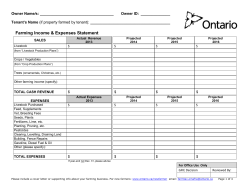
Animals of the rainforest
Animals of the rainforest Introduction There are many different types of animals in the rainforest and there is a lot of competition for food and habitats, so some species become specialised and adapt to eat things that few others do. They also use colours to camouflage themselves or to warn off predators. Adapting to the environment… • Everybody adapts to their environment. For example, when you go on holiday (to a hot country) you may get a sun tan – this is actually protection against sun damage (something that your skin is not used to in the UK) • Look at how this GOLDFISH has adapted to its environment… Large fin on back of fish to help swim in the right direction Large tail to help propel fish through the water Gills so that the fish can breathe under water Big eyes to see all around, under water Animals of the RAINFOREST… • There are a variety of different animals that live in the rainforest. • Each and every one of them has adapted to their environment. • Different layers of the rainforest offer different environments for the animals to live • The next slides show what they are like, and how they have adapted to their environment. Toucan Bright colours are to attract a mate. Strong claws can grip onto trees/ branches easily Toucans nest in tree holes to keep themselves hidden from prey. The large colourful bill is meant to deter predators. Strong bill to crack open nuts Anteater (vested) Huge paws with claws allow it to open nests. Lives in the canopy and on the ground. Long tail helps to climb trees and balance. Long Sticky tongue to get ants or termites out of their nests. Central American Squirrel Monkey Huge tails for balance in the canopy where they live. Paws are like hands to eat fruit and nuts, and to help grip trees. Squirrel monkeys leap through the trees so have short, strong thighs to give them more power when they jump. Heliconid Butterfly Wings are camouflaged to look like leaves. Rhinoceros Beetle Large horn for defensive purposes. Very hard protective shell. Very loud hissing to frighten off predators. Poison dart frog They spit out poison as a defence. Suction pads on the toes help to cling to trees and leaves when climbing. Bright colour is used to warn off predators. Red Eyed Tree Frog has suction cups on its toes that enable it to climb trees and on leaves The Red-Eyed Tree Frog is well known for its bulging red eyes and beautiful blue streaks and orange toes. When the Tree Frog sleeps it hides its sharp colours Lives near ponds, streams and rivers Feeds on smaller frogs, insects and crickets Great Hornbill The main food the Hornbill eats is fruit. It also eats small lizards, insects, snakes and small mammals. They find shelter in the small openings of trees They can fly over larges areas of the forest in one day, just in search of food. The casque, on the top of the Hornbill’s head, acts as an amplifier for its calls. Siamang The Siamang is arboreal - meaning they spend most of their lives in the trees the diet consists mostly of fresh leaves and fruit. They will also consume nuts, insects, eggs and small vertebrates They swing from tree to tree using their arm only. They can carry things with their feet when they do this. Reticulated Python Diet consist of birds, mammals of different sizes including deer and pigs and on very rare occasions possibly The Reticulated Python can usually be found near water, including ponds and rivers humans It will use its large muscular body to constrict and suffocate its prey. The average length of an adult Reticulated Python can range from 15 - 25 feet making it the longest snake and reptile in the world Jaguar Can swim and climb trees to get their prey. Three-Toed sloth Moves extremely slowly so it doesn’t draw attention to itself from predators Very strong legs and claws to hang still for a long time. Greenish algae on its fur provides camouflage Pitcher plant Contains a liquid inside that attracts insects, once they are in they cannot escape. The cup part of the plant has a lid that closes so that the liquid inside does not become diluted in heavy rainfall. Your turn… • After looking at all of those animals of the rainforest, its your turn to design your OWN animal that could survive in the rainforest. • HOWEVER, you MUST be able to say WHY you have designed your animal in such a way. • For instance, if you have put a fish like tail on your animal, you must be able to say why! • Add labels to your design (in detail) and remember to give it a name! It can be as weird and wacky as you like! Things to think about: What is your animal called? Which layer of the rainforest does your animal live in? What does your animal like to eat? Who likes to eat your animal?! Is your animal at risk from people? How has your animal adapted to rainforest conditions? What does your animal look like? What is the level of work your are producing? (See mark scheme for plant and animal design worksheet)
© Copyright 2025





















